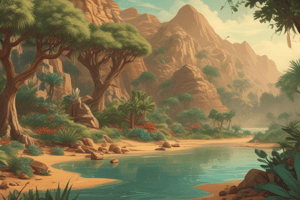Podcast
Questions and Answers
What characterizes the climate in deserts?
What characterizes the climate in deserts?
- High precipitation rates and mild temperatures
- Extreme cold and snowfall throughout the year
- Hot and dry conditions with little rainfall (correct)
- Temperate climate with frequent rainfall
How do desert plants like cacti adapt to the harsh conditions?
How do desert plants like cacti adapt to the harsh conditions?
- By growing long roots to reach underground water sources
- By losing leaves to avoid water loss
- By absorbing excess water through their roots
- By storing water in succulent tissue (correct)
What is a common strategy for desert-dwelling reptiles to conserve moisture?
What is a common strategy for desert-dwelling reptiles to conserve moisture?
- Drinking large quantities of water daily
- Urinating frequently to eliminate excess fluid
- Staying active during the hottest parts of the day
- Generating concentrated urine and limiting activity during heat (correct)
Which of the following is a true statement about deserts?
Which of the following is a true statement about deserts?
What adaptation do some desert animals have to cope with water scarcity?
What adaptation do some desert animals have to cope with water scarcity?
How do some desert plants survive long periods without water?
How do some desert plants survive long periods without water?
Why do some birds have a gland above their eyes that produces a clear salty fluid?
Why do some birds have a gland above their eyes that produces a clear salty fluid?
What is the purpose of succulent tissue in plants like cacti and agaves?
What is the purpose of succulent tissue in plants like cacti and agaves?
How are sand dunes formed in desert landscapes?
How are sand dunes formed in desert landscapes?
What role do adaptations like spines on thorny plants play in desert ecosystems?
What role do adaptations like spines on thorny plants play in desert ecosystems?
Which desert is known to host a plethora of microorganisms thriving under extreme conditions?
Which desert is known to host a plethora of microorganisms thriving under extreme conditions?
What is a common feature of desert ecosystems despite their seemingly barren appearance?
What is a common feature of desert ecosystems despite their seemingly barren appearance?
Flashcards are hidden until you start studying
Study Notes
Deserts
Deserts are arid regions characterized by low precipitation rates and high temperatures. They cover approximately one-fifth of the Earth's land surface. Deserts can be found all over the world, with some of the most famous examples being the Sahara in Africa, the Kalahari in South Africa, the Mojave and Sonoran in North America, and the Antarctic Dry Valleys in Antarctica.
Climate
The climate in deserts is typically hot and dry due to their location in subtropical zones with little rainfall. Temperatures can reach extreme levels during the day, often exceeding 38°C (100°F), while dropping dramatically at night to below freezing point. Rainfall is extremely rare and usually occurs only a few times per year.
Adaptations
Plants and animals living in desert environments have developed various strategies to cope with these harsh conditions. Some plants store moisture in their leaves to survive long periods without water. Others, like cacti, have adapted to store water in specialized tissues called succulent tissue. These adaptations help them endure extended periods of drought.
Animals, too, have evolved specific traits to live in desert conditions. For instance, many desert-dwelling reptiles conserve moisture by urinating infrequently, generating concentrated urine, and limiting their activity during the hottest parts of the day. Additionally, some birds have developed a gland above their eyes that produces a clear salty fluid to keep their eyes lubricated when food is scarce.
Ecosystems
Despite their seemingly barren appearance, deserts are home to diverse ecosystems teeming with life. These ecosystems vary depending on the availability of water and nutrients. For example, the Sonoran Desert in Arizona has vast areas covered with drought-tolerant plants forming ecological niches, accommodating numerous animal species. Similarly, the Atacama Desert in Chile hosts a plethora of microorganisms that thrive under extreme conditions.
Sand Dunes
Sand dunes are common features in desert landscapes. They are formed by wind depositing grains of sand on sloping ground. This process creates intricate patterns and shapes, from wide ridges known as star dunes to tall linear formations like barchans. Wind erosion and deposition sculpt these structures, which can change rapidly in response to environmental factors such as rain, wind direction, and human activities.
Plant Life
Desert flora is incredibly diverse, from small annual plants like poppies to large shrubs and trees. Plants like cacti and agaves have succulent tissue that allows them to store water efficiently during dry periods. They also develop adaptations such as spines on thorny plants to prevent damage from herbivores or excessive sunlight. Despite these challenges, desert ecosystems host various types of plant life that play essential roles in their food chains.
In conclusion, deserts are unique environments characterized by extreme climates, diverse flora and fauna adaptations, vibrant ecological niches, and captivating geographical features. Understanding these aspects enriches our appreciation for the resilience of life on Earth and the complex processes shaping our planet's landscapes.
Studying That Suits You
Use AI to generate personalized quizzes and flashcards to suit your learning preferences.




